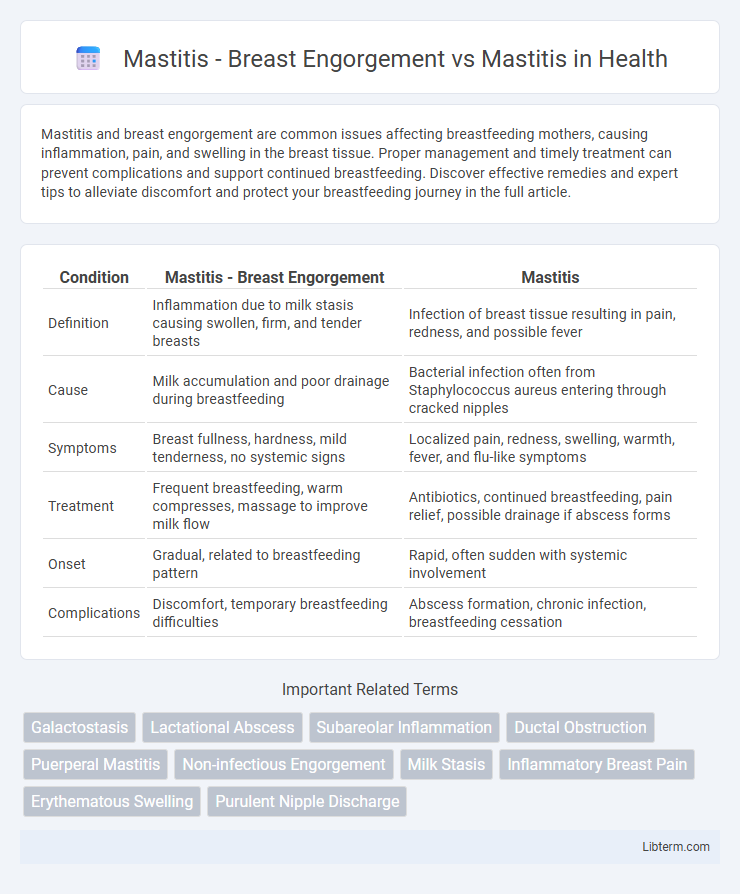Mastitis and breast engorgement are common issues affecting breastfeeding mothers, causing inflammation, pain, and swelling in the breast tissue. Proper management and timely treatment can prevent complications and support continued breastfeeding. Discover effective remedies and expert tips to alleviate discomfort and protect your breastfeeding journey in the full article.
Table of Comparison
| Condition | Mastitis - Breast Engorgement | Mastitis |
|---|---|---|
| Definition | Inflammation due to milk stasis causing swollen, firm, and tender breasts | Infection of breast tissue resulting in pain, redness, and possible fever |
| Cause | Milk accumulation and poor drainage during breastfeeding | Bacterial infection often from Staphylococcus aureus entering through cracked nipples |
| Symptoms | Breast fullness, hardness, mild tenderness, no systemic signs | Localized pain, redness, swelling, warmth, fever, and flu-like symptoms |
| Treatment | Frequent breastfeeding, warm compresses, massage to improve milk flow | Antibiotics, continued breastfeeding, pain relief, possible drainage if abscess forms |
| Onset | Gradual, related to breastfeeding pattern | Rapid, often sudden with systemic involvement |
| Complications | Discomfort, temporary breastfeeding difficulties | Abscess formation, chronic infection, breastfeeding cessation |
Understanding Mastitis and Breast Engorgement
Mastitis is an inflammation of breast tissue caused by bacterial infection, often accompanied by redness, swelling, warmth, and flu-like symptoms, while breast engorgement is a non-infectious condition characterized by excessive milk accumulation causing swollen, firm, and tender breasts. Understanding mastitis involves recognizing symptoms such as localized pain, fever, and systemic illness, requiring antibiotic treatment, whereas breast engorgement typically resolves with frequent breastfeeding and proper milk removal. Differentiating these conditions is crucial to ensure appropriate care and prevent complications like abscess formation in mastitis or breastfeeding difficulties due to engorgement.
Key Differences Between Breast Engorgement and Mastitis
Breast engorgement occurs when the breasts become overly full with milk, causing swelling, tenderness, and firmness, often within the first week postpartum. Mastitis is an infection characterized by breast inflammation, redness, warmth, fever, and flu-like symptoms, typically developing if engorgement is untreated or milk flow is obstructed. The key differences include the presence of infection signs and systemic symptoms in mastitis, while engorgement involves non-infectious breast fullness and discomfort.
Causes of Breast Engorgement
Breast engorgement occurs when milk accumulates in the breasts faster than it is removed, often caused by infrequent nursing, sudden weaning, or an oversupply of milk. The increased blood flow and milk volume lead to swelling, hardness, and tenderness, distinguishing it from mastitis, which involves infection. Proper latch and frequent breastfeeding or pumping are essential in preventing engorgement and alleviating discomfort.
Causes and Risk Factors of Mastitis
Mastitis is primarily caused by bacterial infection, often from Staphylococcus aureus, entering through nipple cracks or fissures, with milk stasis due to poor breastfeeding technique or infrequent feeding increasing susceptibility. Risk factors include breast engorgement, which creates ideal conditions for bacterial growth, cracked nipples, tight clothing restricting milk flow, and a history of mastitis or previous breast surgery. Immune suppression and stress also contribute to higher risk by impairing the body's ability to fight infection effectively.
Common Symptoms: Engorgement vs Mastitis
Breast engorgement typically presents with swollen, firm, and tender breasts, accompanied by warmth and a feeling of fullness due to milk buildup. Mastitis symptoms include localized breast pain, redness, swelling, and systemic signs such as fever, chills, and flu-like symptoms indicating infection. Both conditions cause breast tenderness, but mastitis is distinguished by signs of infection and more severe systemic symptoms.
Diagnosis: How to Differentiate Engorgement from Mastitis
Breast engorgement typically presents with firm, swollen breasts that are tender but without systemic symptoms, whereas mastitis often involves localized breast pain accompanied by fever, redness, and flu-like symptoms. Clinical examination reveals generalized swelling and tightness in engorgement, compared to a well-demarcated inflamed area and sometimes purulent discharge in mastitis. Diagnostic differentiation relies on patient history, physical findings, and may include ultrasound to rule out abscess formation associated with mastitis.
Effective Home Remedies for Breast Engorgement
Breast engorgement and mastitis are common postpartum breast conditions; engorgement occurs when breasts are overly full and swollen, while mastitis involves infection and inflammation. Effective home remedies for breast engorgement include frequent breastfeeding or milk expression to relieve pressure, applying warm compresses to stimulate milk flow, and cold compresses to reduce swelling and pain. Consuming anti-inflammatory foods and staying hydrated also support recovery and improve comfort during engorgement episodes.
Mastitis Treatment and Medical Interventions
Mastitis treatment primarily involves a combination of antibiotics to target bacterial infection and pain relievers to reduce inflammation and discomfort. Medical interventions also emphasize effective breast drainage through frequent breastfeeding or pumping to prevent milk stasis, which is critical for resolving infection. In severe cases, hospitalization and intravenous antibiotics may be necessary to manage abscess formation or systemic symptoms.
Prevention Strategies for Both Conditions
Effective prevention strategies for breast engorgement and mastitis primarily involve frequent breastfeeding or milk expression every 2-3 hours to avoid milk stasis. Maintaining proper latch techniques and breast hygiene reduces the risk of nipple trauma, which can lead to infection. Ensuring adequate hydration, regular breast emptying, and wearing well-fitted supportive bras also contribute to minimizing the incidence of both breast engorgement and mastitis.
When to Seek Professional Medical Help
Breast engorgement typically resolves within a few days postpartum and is characterized by firm, swollen breasts that respond well to frequent breastfeeding or pumping. Mastitis presents with localized breast pain, redness, fever, and flu-like symptoms, indicating infection that requires prompt medical evaluation. Seek professional medical help immediately if symptoms persist beyond 24-48 hours, worsen despite home care, or include high fever, chills, or breast abscess formation to prevent complications.
Mastitis - Breast Engorgement Infographic

 libterm.com
libterm.com